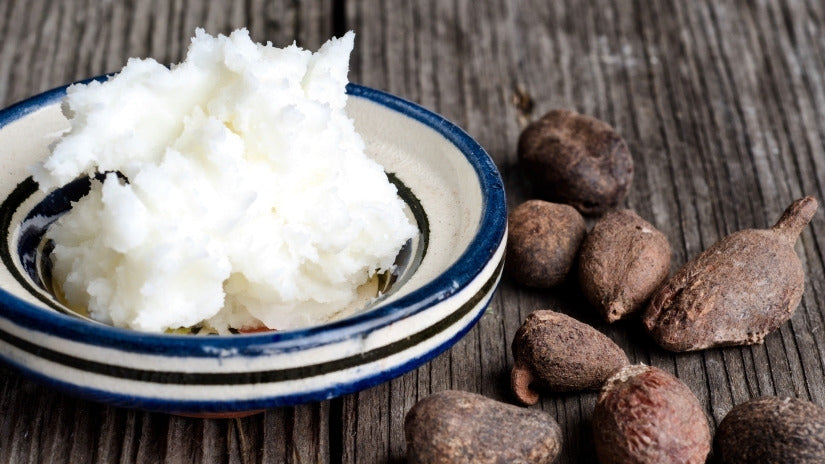
Shea (Karite) Butter Ways to Use and Benefits
Share
Shea Butter: Nature’s Skin Superfood
Shea butter, a remarkable natural ingredient, originates from West Africa, where it has been a staple for centuries. Extracted from the nuts of the Shea (Karité) tree (Vitellaria paradoxa), which is native to countries such as Ghana, Burkina Faso, Nigeria, and Mali, this versatile product is deeply rooted in the traditions of African communities. Locally referred to as "women's gold," it is not only a source of income for many but also a treasured ingredient for health, beauty, and cooking.
Naturally rich in vitamins A, E, and F, shea butter provides UV protection (approximately SPF 6) and delivers essential fatty acids and nutrients vital for collagen production. Its wide range of benefits has made it a favorite ingredient worldwide, while its cultural significance in its countries of origin remains unparalleled.
What is Shea Butter?
Shea butter is extracted from the nuts of the African karité tree, which grows across a broad region stretching from Guinea and Senegal to Uganda and South Sudan. Traditionally, it has been used in West African cultures for cooking, skincare, and as a healing balm for various ailments. Today, it is also a popular ingredient in chocolate production and an essential component in beauty and body care products globally.
Unique Composition
Shea butter owes its exceptional properties to its unique composition of fatty acids and plant sterols, including oleic, stearic, palmitic, and linolenic acids. These compounds contribute to its non-saponifiable properties—it does not turn into soap when exposed to alkalis—enhancing its healing and nourishing potential for the skin.
Benefits of Shea Butter
-
Moisturizing
Packed with natural vitamins and fatty acids, shea butter deeply nourishes and hydrates the skin. It’s especially effective in combating dryness and maintaining the skin’s natural oils. -
Anti-Inflammatory Properties
The cinnamic acid and other compounds in shea butter exhibit anti-inflammatory effects. One compound, lupeol cinnamate, has been shown to reduce skin inflammation and may help prevent certain skin mutations. -
Supports Collagen Production
Shea butter promotes natural collagen production, enhancing skin elasticity and firmness. Consistent use can soften the skin, reduce wrinkles, and improve overall texture. -
Rich in Antioxidants
With high levels of vitamins A and E, shea butter protects the skin from environmental damage and may help prevent UV-related damage. -
Cultural Heritage
In its countries of origin, shea butter is more than just a skincare product. It is deeply integrated into daily life as a natural remedy, cooking oil, and a symbol of economic empowerment, especially for women involved in its production.
Shea Butter Uses
-
Relieve Dry Skin
With its rich composition, shea butter is an excellent moisturizer, soothing even the driest skin. -
Hair Care
Shea butter seals in moisture, defines curls, reduces frizz, and soothes the scalp. It’s a key ingredient in many haircare products. -
Fade Stretch Marks and Scars
Its abundance of vitamins and fatty acids makes it a popular remedy for reducing the appearance of stretch marks and scars. -
Lip Care
Shea butter hydrates and protects lips, especially in dry or cold climates. -
Eczema and Acne Relief
Its anti-inflammatory and moisturizing properties make it a gentle option for managing eczema and acne. -
Repair Cracked Heels and Cuticles
Apply shea butter to rough or cracked areas before bed for smooth, soft skin by morning. -
Insect Bite Relief
Shea butter soothes itching and swelling caused by insect bites, thanks to its anti-inflammatory compounds. -
Congestion Relief
A study published in the British Journal of Clinical Pharmacology found that shea butter can clear nasal congestion effectively when applied inside the nostrils.
Choosing the Best Shea Butter
When shopping for shea butter, prioritize raw, unrefined, or Grade A varieties. These retain the most nutrients and beneficial properties. Unrefined shea butter is slightly harder in texture and has a nutty aroma, while refined versions are smoother and odorless but may lose some of their effectiveness during processing.
Shea butter’s journey from the Shea belt of Africa to skincare shelves worldwide is a testament to its extraordinary versatility and effectiveness. It’s not just a product; it’s a cultural heritage, a natural remedy, and a beauty essential rolled into one.
